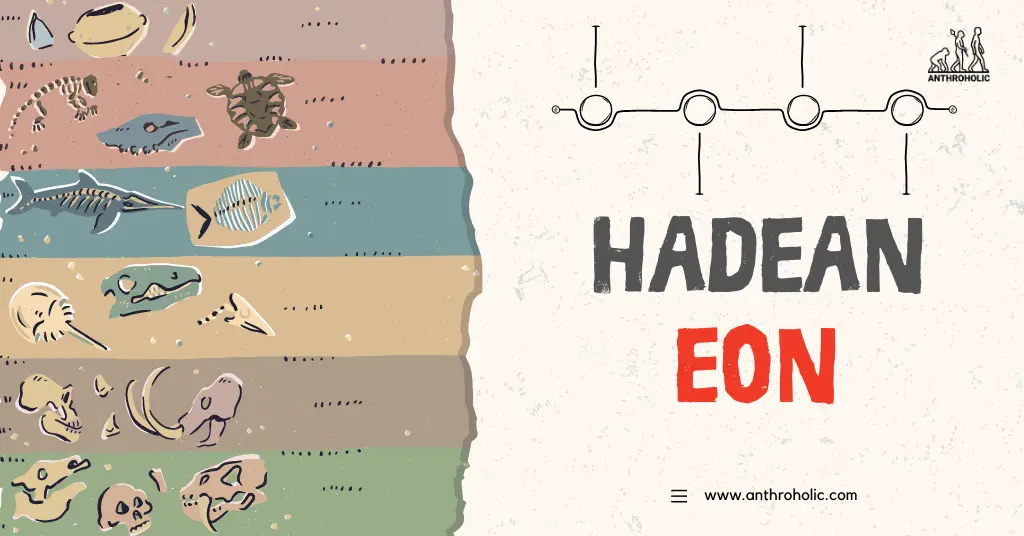AI Answer Evaluation Platform Live Now. Try Free Answer Evaluation Now
Hadean Eon
The Hadean Eon, named after Hades, the ancient Greek god of the underworld, represents the first geological eon of Earth’s history. This mysterious period of Earth’s earliest days remains largely enigmatic due to the limited fossil and geological records available [1]. This article will delve into the known elements of the Hadean Eon, its chronology, characteristics, and its significance in our understanding of the Earth’s history.

Overview of the Hadean Eon
The Hadean Eon stretches from about 4.6 to 4 billion years ago, starting from the formation of the Earth after the Solar System’s creation to the first reliable geological record [2]. This eon has no formal subdivisions due to the scarce rock record from this period; however, it’s often divided into Early, Middle, and Late periods.
Characteristics of the Hadean Eon:
- Intense volcanic activity.
- High surface temperature.
- Frequent asteroid impacts.
- Formation of the first oceans.
Chronology of the Hadean Eon:
| Period | Age (Billion years ago) |
|---|---|
| Early Hadean | 4.6 – 4.4 |
| Middle Hadean | 4.4 – 4.2 |
| Late Hadean | 4.2 – 4.0 |
Geological and Atmospheric Conditions
The Hadean Eon witnessed the Earth in its infancy, experiencing extreme conditions that made life untenable. It’s often depicted as a violent, hellish time, hence its name derived from Hades.
Geological Conditions:
- Frequent Meteor Impacts: The early Hadean was marked by frequent meteor impacts, which were part of the late heavy bombardment period [3]. These impacts were so intense that they often melted the surface of the Earth, creating a magma ocean.
- Volcanic Activity: The high level of volcanic activity was another major feature of this eon. The heat from these activities contributed to the high surface temperatures [4].
- Formation of the First Crust: Despite the intense conditions, it’s believed that the first stable crust began to form in the late Hadean [5].
Atmospheric Conditions:
- No Free Oxygen: The Hadean atmosphere had almost no free oxygen. Instead, it was predominantly composed of greenhouse gases like carbon dioxide and methane, which contributed to a hot global climate [6].
- Possible Presence of Water: Despite the high temperatures, it’s theorized that the first primitive oceans began to form in the late Hadean, as evidenced by the discovery of zircon crystals that indicate the presence of liquid water [7].
Life in the Hadean Eon
Despite the hostile conditions of the Hadean Eon, it played a vital role in setting the stage for the origins of life.
The Origin of Life:
- Emergence of Organic Molecules: The conditions in the Hadean Eon were conducive to the formation of simple organic molecules, the precursors to life [8].
- Presence of Water: The potential presence of liquid water towards the end of the Hadean might have provided a conducive environment for the formation of life [9].#9
Significance of the Hadean Eon
The Hadean Eon is vital in understanding the early development of our planet and setting the stage for the emergence of life.
- Understanding Earth’s Formation: Studying the Hadean Eon provides insights into the physical and chemical processes involved in the Earth’s formation, including core formation and the development of the Earth’s crust and oceans [10].
- Prebiotic Chemistry: Understanding the conditions of the Hadean Eon aids in piecing together the puzzle of life’s origins by studying the formation of the first organic molecules [11].
Geological Evidence and Research on the Hadean Eon
The Hadean Eon, due to its antiquity, leaves little direct evidence for scientists to analyze. However, specific findings provide critical insights into this mysterious eon.
Detrital Zircons
Zircon is a robust mineral that can survive intense geological processes and store information about its formation conditions. The oldest known terrestrial material, a tiny zircon crystal from Western Australia, is dated back to about 4.4 billion years, within the Hadean Eon [12].
What Detrital Zircons tell us:
- Existence of Continental Crust: The age and composition of these zircons suggest the presence of continental crust earlier than previously believed [13].
- Presence of Liquid Water: Certain characteristics of these zircons indicate that they formed in the presence of liquid water, suggesting the existence of water on Earth’s surface during the Hadean Eon [14].
Lunar Rocks and Impact Craters
The Moon’s surface, largely untouched by plate tectonics or erosion, preserves an early history of the solar system that includes the Hadean Eon. The lunar rocks and impact craters have provided essential clues about the conditions on Earth during the Hadean Eon.
What Lunar Evidence tells us:
- Impact History: The numerous lunar impact craters suggest a heavy bombardment period in the early solar system, which would have significantly affected the Hadean Earth [15].
- Formation of the Moon: The theory of a giant impact leading to the formation of the Moon also gives us a timeframe for the beginning of the Hadean Eon [16].
The End of the Hadean Eon
The Hadean Eon came to an end around 4 billion years ago, marking the beginning of the Archean Eon. This transition is characterized by a decrease in asteroid impacts, more stable crust formation, and the emergence of the first life forms.
Transition to the Archean Eon
- Reduction in Meteor Impacts: The rate of meteor impacts significantly reduced by the end of the Hadean Eon, leading to a more stable surface condition [17].
- Stable Crust and Oceans: As the crust became more stable, water could remain on the surface, leading to the formation of the first oceans [18].
- Emergence of Life: With more stable conditions and the presence of water, the stage was set for the emergence of the first life forms, which likely appeared in the subsequent Archean Eon [19].
Conclusion
While the Hadean Eon remains the least understood era in Earth’s history, advancements in research and discovery of ancient zircon crystals provide glimpses into this primordial time. Unraveling the mysteries of this eon is vital not just to understand our planet’s past, but also to gain insights into the conditions that led to the origins of life.
References
[1] Catling, D. C., Zahnle, K. J., & McKay, C. P. (2001). Biogenic Methane, Hydrogen Escape, and the Irreversible Oxidation of Early Earth. Science, 293(5531), 839-843.
[2] Valley, J. W., et al. (2014). Hadean age for a post-magma-ocean zircon confirmed by atom-probe tomography. Nature Geoscience, 7(3), 219-223.
[3] Sleep, N. H., Zahnle, K., Kasting, J. F., & Morowitz, H. J. (1989). Annihilation of ecosystems by large asteroid impacts on the early Earth. Nature, 342(6246), 139-142.
[4] Harrison, T. M. (2009). The Hadean Crust: Evidence from >4 Ga Zircons. Annual Review of Earth and Planetary Sciences, 37(1), 479-505.
[5] Wilde, S. A., Valley, J. W., Peck, W. H., & Graham, C. M. (2001). Evidence from detrital zircons for the existence of continental crust and oceans on the Earth 4.4 Gyr ago. Nature, 409(6817), 175-178.
[6] Kasting, J. F. (1993). Earth’s early atmosphere. Science, 259(5097), 920-926.
[7] Mojzsis, S. J., et al. (2001). Evidence for life on Earth before 3,800 million years ago. Nature, 384(6604), 55-59.
[8] Miller, S. L. (1953). A production of amino acids under possible primitive Earth conditions. Science, 117(3046), 528-529.
[9] Knauth, L. P. (2005). Temperature and salinity history of the Precambrian ocean: implications for the course of microbial evolution. Palaeogeography, Palaeoclimatology, Palaeoecology, 219(1-2), 53-69.
[10] Canup, R. M. (2004). Simulations of a late lunar-forming impact. Icarus, 168(2), 433-456.
[11] Sleep, N. H., Bird, D. K., & Pope, E. C. (2011). Serpentinite and the dawn of life. Philosophical Transactions of the Royal Society B: Biological Sciences, 366(1580), 2857-2869.
[12] Wilde, S. A., Valley, J. W., Peck, W. H., & Graham, C. M. (2001). Evidence from detrital zircons for the existence of continental crust and oceans on the Earth 4.4 Gyr ago. Nature, 409(6817), 175-178.
[13] Harrison, T. M., Blichert-Toft, J., Müller, W., Albarede, F., Holden, P., & Mojzsis, S. J. (2005). Heterogeneous Hadean hafnium: evidence of continental crust at 4.4 to 4.5 ga. Science, 310(5756), 1947-1950.
[14] Valley, J. W., Cavosie, A. J., Ushikubo, T., Reinhard, D. A., Lawrence, D. F., Larson, D. J., … & Spicuzza, M. J. (2014). Hadean age for a post-magma-ocean zircon confirmed by atom-probe tomography. Nature Geoscience, 7(3), 219-223.
[15] Tera, F., Papanastassiou, D. A., & Wasserburg, G. J. (1974). Isotopic evidence for a terminal lunar cataclysm. Earth and Planetary Science Letters, 22(1), 1-21.
[16] Canup, R. M., & Asphaug, E. (2001). Origin of the Moon in a giant impact near the end of the Earth’s formation. Nature, 412(6848), 708-712.
[17] Strom, R. G., Malhotra, R., Ito, T., Yoshida, F., & Kring, D. A. (2005). The origin of planetary impactors in the inner solar system. Science, 309(5742), 1847-1850.
[18] Sleep, N. H. (2010). The Hadean-Archaean Environment. Cold Spring Harbor Perspectives in Biology, 2(6), a002527.
[19] Nisbet, E. G., & Sleep, N. H. (2001). The habitat and nature of early life. Nature, 409(6823), 1083-1091.



